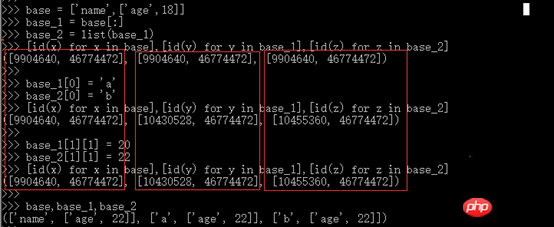Home > Article > Backend Development > A brief introduction to assignment & shallow copy & deep copy in Python (example)
This article brings you a brief introduction (example) about assignment, shallow copy, and deep copy in Python. It has certain reference value. Friends in need can refer to it. I hope it will be helpful to you.
When writing the dict data type, we mentioned the "assignment statement" and the copy() function.
In fact, when it comes to deep and shallow copies, specific data types need to be considered. One part is immutable objects, such as numbers and strings; the other part is mutable objects, such as lists, dictionaries, etc.
Variable: An element of a system table that points to the connection space of the object.
Object: A piece of memory allocated to store its actual value.
Reference: Pointer from variable to object.
Immutable objects: Once created, they cannot be modified, such as numbers, strings, and tuples.
Variable objects: Objects that can be modified, such as lists and dictionaries.
Assignment: Achieved through the statement "=". The left side is the newly created variable, and the right side can be the direct content or the existing variable. It is a reference to the object. Python does not copy the object, but only copies the reference to the object. The new variable points to the memory address of the source variable.
Shallow copy: Copy an object. The outermost object itself is copied, and the internal elements are just copied with a reference. That is, a new object is created whose type is the same as the original object and whose content is a reference to the original object. [The shallow copy object is new, and the reference content of the object is old. 】
Several ways to implement shallow copy: (1) Slice: [:]; (2) Factory function, such as list(), dict(); (3) Use copy().
Deep copy: Both peripheral and internal elements copy the object itself, not the reference. That is, the object is copied once, and other objects referenced in the object are also copied.
For immutable objects, such as numbers and strings, assignment (=), shallow copy ( There is no difference between copy()) and deepcopy() because their object references always point to the same memory address.
Demonstration through examples:
>>> var_1 = 123 >>> id(var_1) # 通过id()查看地址 1615552144 >>> var_2 = var_1 >>> id(var_2) 1615552144 >>> >>> import copy # 浅、深拷贝需要导入copy模块 >>> var_3 = copy.copy(var_1) >>> id(var_3) 1615552144 >>> >>> var_4 = copy.deepcopy(var_1) >>> id(var_4) 1615552144
You will find that the id points of var_1 ~ var_4 are the same.
For list, dict and other data types, assignment, shallow copy and deep copy have different changes in memory addresses. .
Assignment shallow copy: Equal values, equal addresses;
copy shallow copy: Equal values, unequal addresses;
deepcopy deep copy:The values are equal, but the addresses are not equal;
Example 1:
base[0]='name', which is a string, immutable object; base[1]=[ 'age',18], is a list, a mutable object.
base_1 and base_2 are both shallow copies of base, and the three have the same id().
When different changes are made to the first string element, it is found that the ids are different and will not affect each other, because the string (immutable) is copied displayed, and when modified, a new character object is created.
When modifying the second list element, different modifications will only take effect on the last modification and affect each other, because the second element list simply copies its reference. Modifying any shallow copy will modify the reference. Content.

Example 2: Deep copy
Create a dictionary object and use deep copy to create a new object.
>>>import copy
>>> var = {"a":1,"b":2,"c":[3,'abc']}
>>> var1 = copy.deepcopy(var)
>>> id(var),id(var1)
(17616992, 15671136) # 地址不相同
>>> id(var['c']),id(var1['c'])
(15695144, 15695384)
>>> id(var['c'][0]),id(var1['c'][0])
(1615550224, 1615550224) # ‘c’元素的内存地址是相同的
>>>
>>> var1['c'][0] = 4
>>> var
{'a': 1, 'b': 2, 'c': [3, 'abc']}
>>> var1
{'a': 1, 'b': 2, 'c': [4, 'abc']}
>>> id(var['c'][0]),id(var1['c'][0])
(1615550224, 1615550240) # 对var1的修改没有影响var
Related recommendations:
Organizing assignment operators in Python
Assignment, shallow copy, deep copy in Python Copy introduction
The above is the detailed content of A brief introduction to assignment & shallow copy & deep copy in Python (example). For more information, please follow other related articles on the PHP Chinese website!